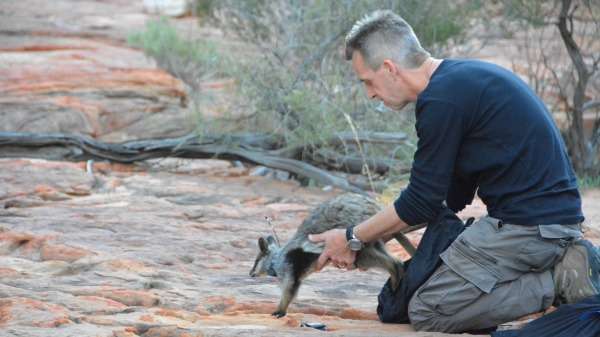Releasing a radio-collared black-flanked rock wallaby into Kalbarri National Park. Credit: Kalbarri Adventure Tours
The stunning environs of Kalbarri National Park are alive once again with the presence of black-flanked rock-wallabies (Petrogale lateralis) after Department of Parks and Wildlife (DPAW) staff and volunteers released 23 new wallabies into the gorge in May.
The release will augment a very small existing population that was discovered after a rock climber photographed two adult wallabies living in a remote area of the park in August last year.
The sighting of the tiny population was the first record of the wallabies in the park in the past two decades. They had been presumed locally extinct, having fallen victim to fox and cat predation, and habitat damage caused by feral goats.
The new wallabies were translocated from Mt Caroline Nature Reserve and Nangeen Hill, a predator-proof fenced nature reserve, near Kellerberrin in the Wheatbelt.
DPAW staff, volunteers and WWF staff caught the animals in traps overnight, placed them into petpacks and on a special charter flight to Kalbarri.
Once in Kalbarri, the rock-wallabies were fitted with radio-collars. In the late afternoon, DPAW staff, local Bush Ranger students and WWF staff hiked into two remote parts of the park with the wallabies in backpacks, to release them into their new habitat.
Suitable areas of good wallaby habitat had been identified beforehand, each with plenty of caves, crevices and areas to graze.
The breakdown
Ten female and 10 male wallabies found new homes near the section of the park known as Four Ways, while three female wallabies were released close to the existing population at Z-Bend.
Kalbarri senior ranger Mike Paxman says they avoided releasing all of the wallabies near the existing population to encourage the perpetuation of Kalbarri wallabies' unique genetics.
If numerous Wheatbelt rock-wallabies had been released at the site, then it was likely that the Kalbarri population would have been swamped by the near arrivals and their unique genetic material lost.
"The existing population is at a very high risk of extinction–such a small population is extremely vulnerable to predators or other factors such as drought," Mr Paxman says.
"This augments the population with less dilution of any unique genetic material they may have evolved."
Daily monitoring of the wallabies has revealed they are alive and actively exploring their new homes. DPAW's existing feral goat and fox control program will now also be supplemented with cat baiting using Eradicat bait.
The project is funded by DPaW, the Australian Government's National Landcare Programme and WWF-Australia.
Provided by Science Network WA
This article first appeared on ScienceNetwork Western Australia a science news website based at Scitech.
























